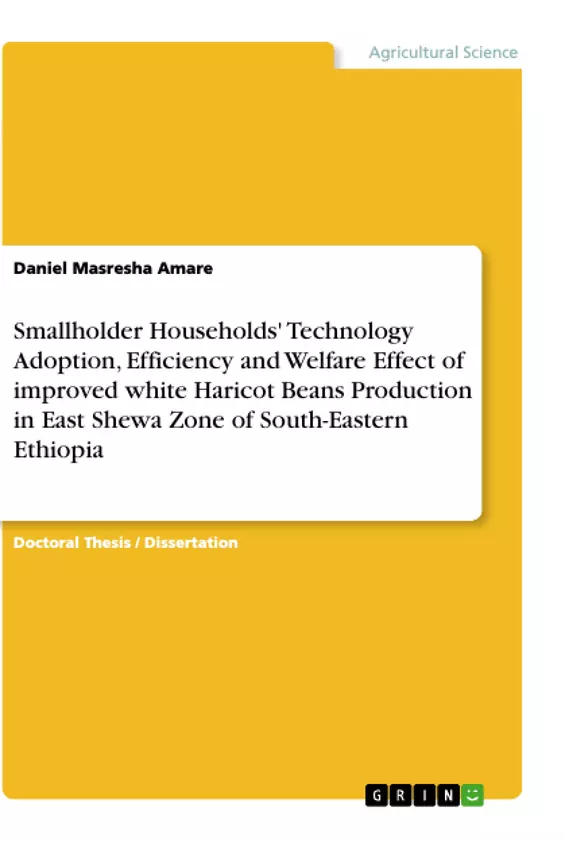White haricot bean is the major source of cash in domestic and international markets and serves as the cheapest source of protein diet for rural households. The double hurdle model and parametric stochastic frontier model of Cobb Douglass type production and cost functions were used to analyze the determinants of adoption and estimate production and cost efficiency scores, respectively. The adoption study revealed that the two decision tiers are independent and the same or different factors affected the two tiers. The decision to adopt is positively and significantly influenced by the frequency of extension contacts, landholding size, agricultural income, perception of the household heads (about price, contribution to soil fertility and nutritional importance), training, and crop diversification; and negatively by distance to market and form of possession of haricot bean plot (tenure).
The intensity of adoption is positively affected by non-farm income, contact with NGOs, and negatively with the number of dependents and form of possession of haricot beans plot (tenure). Technical efficiency is significantly and positively influenced by sex (male=1), membership in farmers cooperatives, education of the family, experience in haricot beans farming, use of certified seeds, income from the farm sector and crop diversification; and negatively affected by age of the households. Allocative efficiency differential is significantly and positively influenced by farming experience and household size; and negatively influenced by sex, distance to market and fragmentation of land. Economic efficiency is significantly and positively affected by the education of the family and household size, and negatively by distance to market and fragmentation of land.
Provision of improved extension services, enhancing the perceptions on the important attributes of the crop, training, and better access to market are proposed for the first-hand adoption of white haricot beans while works on the creation of alternative sources of income (non-farm activities) contribute more to the intensity of adoption. Supply of certified seeds, education of the households and family members, and access to resources (credit and other inputs, in particular for female-headed households) are proposed to improve the technical efficiency, allocative and economic efficiencies.
Inhaltsverzeichnis (Table of Contents)
- 1. INTRODUCTION
- 1.1. Background
- 1.2. Problem Statement
- 1.3. Research Questions
- 1.4. Research Objectives
- 1.5. Significance of the Study
- 1.6. Scope and Limitations of the Study
- 1.7. Organization of the Dissertation
- 2. LITERATURE REVIEW
- 2.1. Production System andBenefits of Haricot Beans
- 2.2. Conceptual Issues
- 2.3. Theoretical Framework
- 2.4. Methodological Framework
- 2.5. Analytical Framework
- 2.6. Empirical Review on Farm Technology Adoption, Efficiency and Welfare Effect
- 2.7 Conceptual Framework
- 3. RESEARCH METHODOLOGY
- 3.1. Description of the Study Area
- 3.2. Sampling Design
- 3.3. Methods of Data Collection
- 3.4. Methods of Data Analysis
- 3.5. Definition of Variables, Measurements and Working Hypotheses
- 4. RESULTS AND DISCUSSION
- 4.1. Household and FarmCharacteristics
- 4.1.1. Household demographic and socio-economic characteristics
- 4.2. Determinants of Status and Intensity of Adoption of Improved White Haricot Beans
- 4.3. Efficiency Analysis
- 4.4. WELFARE EFFECT ANALYSIS
- 5. SUMMARY, CONCLUSION AND RECOMMENDATIONS
- 5.1. Summary
- 5.2. Conclusion and Recommendations
Zielsetzung und Themenschwerpunkte (Objectives and Key Themes)
This dissertation examines the adoption of improved white haricot bean production technologies by smallholder households in the East Shewa Zone of southeastern Ethiopia. The study seeks to understand the factors influencing the adoption of these technologies, analyze their efficiency, and assess their impact on the welfare of smallholder households.
- Technology adoption and its determinants among smallholder households
- Efficiency of improved white haricot bean production technologies
- Welfare impact of technology adoption on smallholder households
- Socioeconomic and demographic factors affecting technology adoption and welfare
- Policy recommendations for promoting sustainable and equitable agricultural development in the region
Zusammenfassung der Kapitel (Chapter Summaries)
- Chapter 1: Introduction: This chapter provides a background to the study, identifies the problem statement, and articulates the research questions and objectives. It also highlights the significance of the study and its scope and limitations, outlining the organization of the dissertation.
- Chapter 2: Literature Review: This chapter provides a comprehensive review of the existing literature on haricot bean production systems, conceptual issues related to technology adoption, efficiency, and welfare effects, and the theoretical and methodological frameworks used in the study. It also includes an empirical review on farm technology adoption, efficiency, and welfare effects.
- Chapter 3: Research Methodology: This chapter describes the study area, sampling design, data collection methods, data analysis methods, and definitions of variables and working hypotheses.
- Chapter 4: Results and Discussion: This chapter presents the findings of the study, examining household and farm characteristics, determinants of technology adoption, efficiency analysis, and welfare impact analysis.
- Chapter 5: Summary, Conclusion and Recommendations: This chapter summarizes the major findings, draws conclusions based on the study's results, and provides recommendations for policy and practice to improve the adoption and impact of improved white haricot bean production technologies in the East Shewa Zone.
Schlüsselwörter (Keywords)
The dissertation focuses on the themes of smallholder agriculture, technology adoption, efficiency, welfare impact, improved white haricot bean production, and agricultural development in Ethiopia. Key concepts explored include farm technology adoption, resource use efficiency, socioeconomic factors, production systems, and policy interventions to promote sustainable and equitable agricultural development.
- Citar trabajo
- Dr. Daniel Masresha Amare (Autor), 2018, Smallholder Households' Technology Adoption, Efficiency and Welfare Effect of improved white Haricot Beans Production in East Shewa Zone of South-Eastern Ethiopia, Múnich, GRIN Verlag, https://www.grin.com/document/924096



